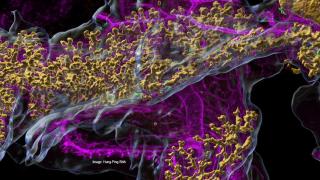City of Hope’s position as a leader in research and bioscience was once again evident at the recent Los Angeles Bioscience Ecosystem Summit (LABEST), the premier showcase for bioscience innovation in Los Angeles County. The event is a collaboration with colleagues from across the county to present promising academic research and entrepreneurial faculty investigations.
The summit aims to promote awareness of the growing life science entrepreneurship in Los Angeles and foster partnerships with the biotechnology and life industry.
City of Hope investigators presented the latest innovations and discoveries, highlighted here:
- Michael Caligiuri, M.D., presented a proprietary manufacturing process of allogeneic, off-the-shelf, human chimeric antigen receptor (CAR) natural killer (NK) cell therapy that enables considerable expansion from human cord blood, followed by viable cryopreservation of the CAR NK cells. The platform was used to generate an ACE2 CAR NK cell product that can be evaluated to treat SAR CoV-2 infection.
- Don Diamond, Ph.D., presented research he and his team have done to develop City of Hope’s own vaccine for COVID-19 using the same platform employed for the Triplex vaccine used to treat cytomegalovirus. A clinical trial is ongoing and further development is planned.
- Mark LaBarge, Ph.D., introduced a study entitled, “Volume-constrained microcontainers enable myoepithelial functional differentiation in highly parallel mammary organoid culture,” an approach that enables statistically robust experimental designs and the ability to culture reconstituted mammary organoids without the impediment of exogenous matrix for up to a year.
- Linda Malkas, Ph.D., focused on how genomic instability and DNA repair alterations lie at the heart of cancer and metastasis, and presented a first-of-its-kind therapeutic that globally targets the DNA repair pathway of cancer cells.
- Guido Marcucci, M.D., discussed a microRNA called MiRisten, a novel and unique City of Hope drug that eliminates leukemia stem cells by arteriolar devascularization of the bone marrow niche in acute myeloid leukemia.
- Javier Gordon Ogembo, Ph.D., shared his research on a vaccine that targets five spike proteins important for EBV infection into various cell types. This vaccine aims to elicit potent neutralizing antibodies that could prevent primary Epstein-Barr virus infection and the high global health burden of EBV-associated diseases.
- Bart Roep, Ph.D., presented findings that could lead to a potential cure for type 1 diabetes using a proprietary CAR Treg therapy aimed at protecting islet beta cells from auto-immune eradication.
- Yanhong Shi, Ph.D., described an efficient and cost-effective platform that can be used to generate induced pluripotent stem cell-based cell therapy for a variety of diseases, and presented how this technology can be used for the treatment of Canavan disease, a devastating neurological disease.
- Debbie Thurmond, Ph.D., shared her team’s discovery of DOC2B, the earliest biomarker known to diagnose diabetes in asymptomatic patients, which could therefore prevent the onset of type 1 and type 2 diabetes.
- Nagarajan Vaidehi, Ph.D., discussed the use of her computation methods, which are based on constrained molecular dynamics simulation methods with emphasis on application to G-protein coupled receptors, to design highly specific modulators (small molecule inhibitors or activators for any protein) and decrease off-target effects.
- Anna Wu, Ph.D., presented her research on how tumor-specific antibodies recognizing PSCA, a promising target in prostate and pancreatic cancer, have been engineered to create drugs optimized for delivering therapeutic radioisotopes directly to tumors in patients.
- John Zaia, M.D., discussed bringing novel cellular therapies to the clinic through state-of-the-art process development methods and explained the work of the Laboratory of Cellular Medicine at City of Hope.
First Place Winners
In addition to the presentations, principal investigators, scientific staff and students representing City of Hope at the Pearl Cohen Poster Competition took home prizes for their research. City of Hope placed first in two of the seven categories: Marwa Ben Haj Salah, a Ph.D. candidate in the lab of John Rossi, Ph.D., took first place in the “Precision Medicine” poster category, and Ralf Buettner, Ph.D., in the lab of City of Hope provost and chief scientific officer Steven T. Rosen, M.D., took first place in the “Cancer” poster category.
Harlan Levine, M.D., Ildiko Csiki, M.D., Ph.D., chief commercial research and development officer at City of Hope, and Rosen, the Irell & Manella Cancer Center Director's Distinguished Chair, were instrumental in securing City of Hope’s participation in the summit.
“We are in a generation of personalized, precision medicine that is generating new and compelling insights into cancer, diabetes and other life-limiting diseases at a pace we have not experienced before,” said Levine. “Our robust and dynamic presence at LABEST and our performance in the poster competition are clear indicators of the impact of our research in advancing scientific discovery and therapeutics. Our participation benefits not only our City of Hope scientists who presented, but additionally all the attendees from the other institutions and the broader biotech ecosystem here in Los Angeles.”
All of these scientific presentations are now available on video here.
Daniela Castanotto, Ph.D., senior manager of commercial R&D and associate professor of molecular and cellular biology at City of Hope, contributed to this article.
